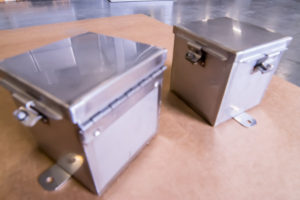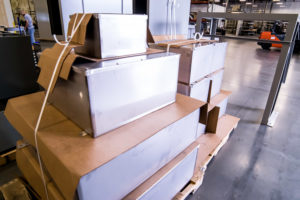 The National Electrical Manufacturers Association (NEMA) sets forth the fabrication requirements for electrical boxes in its 250-2003 standard, “Enclosures for Electrical Equipment”, where performance characteristics of boxes are specified with alphanumerical codes. In applications where there is exposure to dust, water and corrosion, the NEMA Type 4X enclosure is among the most commonly used.
The National Electrical Manufacturers Association (NEMA) sets forth the fabrication requirements for electrical boxes in its 250-2003 standard, “Enclosures for Electrical Equipment”, where performance characteristics of boxes are specified with alphanumerical codes. In applications where there is exposure to dust, water and corrosion, the NEMA Type 4X enclosure is among the most commonly used.
Specifying the right type of enclosures is a key element in the design stage of any electrical project: the selected boxes must provide sufficient protection against particles and liquids to prevent electrical components from being damaged; but it’s also necessary to avoid the specification of boxes with excessive protection for the application at hand, since it produces an unnecessary increase in project costs.
What Degree of Protection Do NEMA 4X Boxes Offer?
NEMA 4X boxes are suitable for harsh environments of many types, thanks to their remarkable protection characteristics:
- They isolate energized electrical components from personnel, greatly reducing the risk of electric shock or fire.
- They offer protection against the entrance of dust and other small particles. NEMA 4X boxes can even withstand dust blown by the wind.
- They offer protection against the entrance of water in all of its forms, including rain, sleet, ice and snow. These boxes can even protect electrical components from a direct jet of water from a hose, which makes them suitable for washdown.
- NEMA 4X boxes resist corrosion. They are typically manufactured from metals such as stainless steel or aluminum, or non-metals like fiberglass and polycarbonate.
 Their performance characteristics make NEMA 4X boxes particularly suitable for solar and wind power applications, since these renewable energy systems are exposed to the weather all of the time. NEMA 4X boxes are also suited for industrial environments where corrosive agents are present.
Their performance characteristics make NEMA 4X boxes particularly suitable for solar and wind power applications, since these renewable energy systems are exposed to the weather all of the time. NEMA 4X boxes are also suited for industrial environments where corrosive agents are present.
It is important to note that, while NEMA 4X boxes can withstand jets of water, they are not suitable for applications where equipment will be fully immersed. An application where there is short-term immersion requires a NEMA 6 enclosure, while one where there will be prolonged immersion requires NEMA 6P.
Another important consideration is that standard NEMA 4X boxes are not explosion-proof, and can’t be used in environments where there are volatile gases, vapors or dusts. In these cases, further requirements apply, and they are determined according to the specific type of explosive compound in the environment.